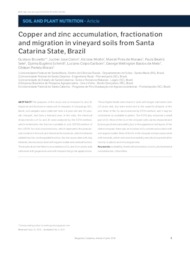Copper and zinc accumulation, fractionation and migration in vineyard soils from Santa Catarina State, Brazil.
Copper and zinc accumulation, fractionation and migration in vineyard soils from Santa Catarina State, Brazil.
Autoria: BRUNETTO, G.; COMIM, J. J.; MIOTTO, A.; MORAES, M. P.; SETE, P. B.; SCHMITT, D. E.; GATIBONI, L. C.; MELO, G. W. B. de; MORAIS, G. P.
Resumo: The purpose of this study was to evaluate Cu and Zn migration and fractions in sandy soil of vineyards. In Urussanga (SC), Brazil, soil samples were collected from a 4-year-old and 15-yearold vineyard, and from a forested area. In the soils, the chemical characteristics of Cu and Zn were analyzed by the EDTA method, which determines the fraction available in soil; 3050B method of the USEPA for total concentrations, which represents the pseudosoil contents in the soil; and chemical fractionation, which estimates soluble fraction, exchangeable fraction, fraction associated with clay minerals, fraction associated with organic matter and residual fraction. The results show that there is accumulation of Cu and Zn in sandy soils cultivated with grapevines and with frequent fungicide applications. These higher levels were found in soils with longer cultivation time (15 years old), but were restricted to the superficial layers of the soil. Most of the Cu was extracted by EDTA method, and it may be considered as available to plants. The EDTA also extracted a small part of Zn. Most of the Cu in the vineyard soils can be characterized by low geochemical mobility, but in the uppermost soil layers of the oldest vineyard, there was an increase in Cu content associated with soil organic matter. Most of the Zn in the vineyard soil was associated with minerals, which indicates low mobility and also low potential for toxicity to plants and microorganisms. Key words: availability, chemical fractionation, toxicity, environmental contamination, Vitisvinifera.
Ano de publicação: 2018
Tipo de publicação: Artigo de periódico
Unidade: Embrapa Uva e Vinho
Palavras-chave: Availability, Chemical fractionation, Copper, Environmental contamination, Toxicity, Vineyard soils, Vitisvinifera, Zinc
Observações
1 - Por padrão são exibidas publicações dos últimos 20 anos. Para encontrar publicações mais antigas, configure o filtro ano de publicação, colocando o ano a partir do qual você deseja encontrar publicações. O filtro está na coluna da esquerda na busca acima.
2 - Para ler algumas publicações da Embrapa (apenas as que estão em formato ePub), é necessário ter, no celular ou computador, um desses softwares gratuitos. Sistemas Android: Google Play Livros; IOS: iBooks; Windows e Linux: software Calibre.
Acesse outras publicações
Acesse a Base de Dados da Pesquisa Agropecuária (BDPA) para consultar o acervo completo das bibliotecas da Embrapa.

